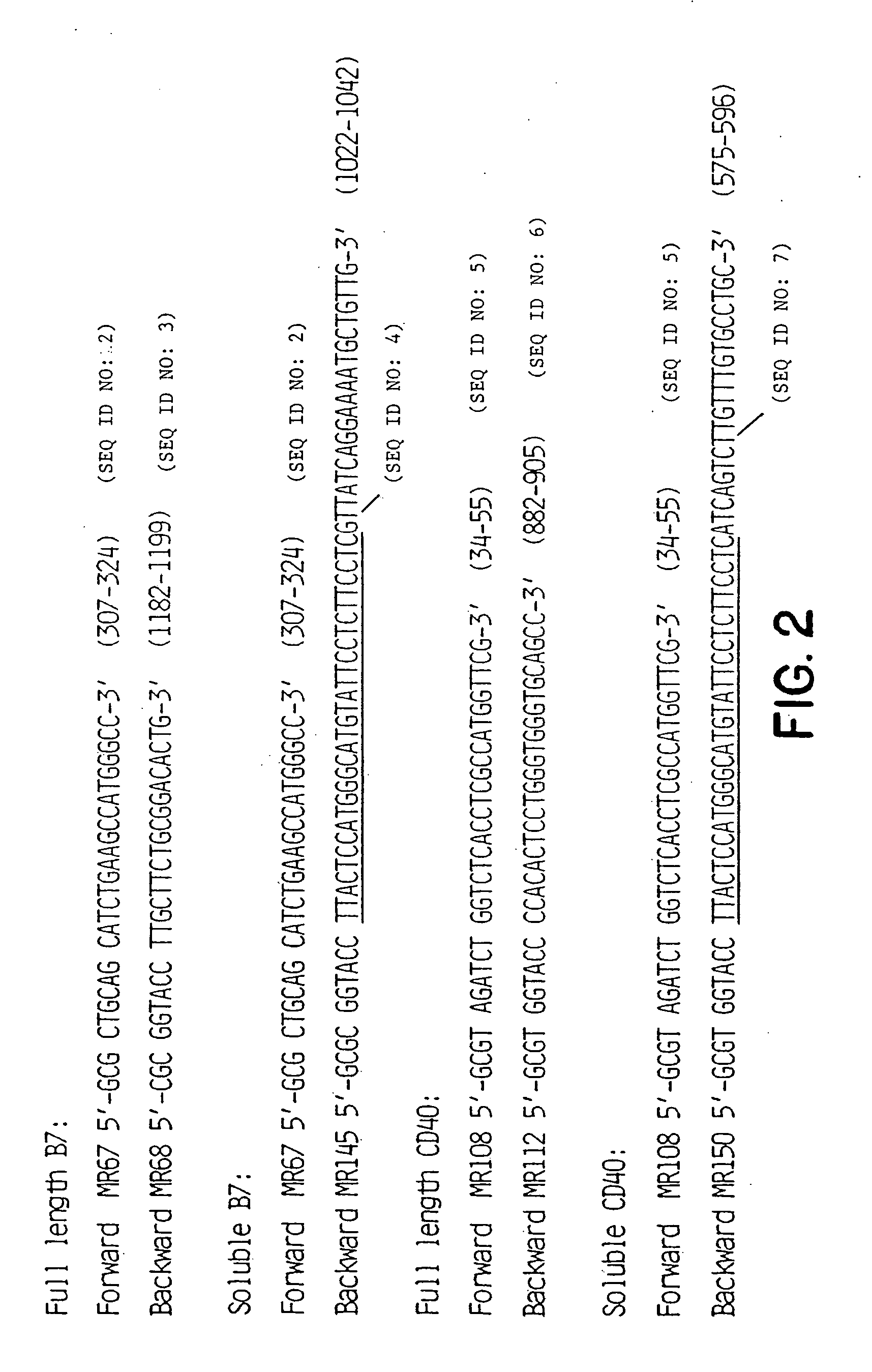Anti-CD40 antibodies capable of blocking B-cell activation
a technology of anti-cd40 antibodies and b-cell activation, applied in the field of new anti-cd40 antibodies capable of blocking b-cell activation, can solve the problem of inability to inhibit the b-cell response, and achieve the effect of preventing the growth or differentiation of b cells
- Summary
- Abstract
- Description
- Claims
- Application Information
AI Technical Summary
Benefits of technology
Problems solved by technology
Method used
Image
Examples
example 1
Making Monoclonal Antibodies to B7 and CD40
A. PCR Cloning of CD40 and B7
[0063] RNA was isolated from a population of EBV-transformed human spleen cells essentially as described by Chirgwin et al., Biochemistry (1979) 17:5294. In brief, the cells were washed twice with phosphate buffered saline (PBS) and lysed in 5 M guanidinium thiocyanate in the presence of 0.7 M 2-mercaptoethanol. The cell lysate was layered on a discontinuous CsCl gradient (Chirgwin et al.) and centrifuged for 16 hours at 26,000 rpm in a Beckman SW28 rotor. The RNA was recovered by dissolving the pellet in DEPC-treated H2O. The RNA was precipitated with ethanol once, resuspended in DEPC-treated H2O, and stored at −70° C.
[0064] Total RNA (10 μg / reaction) was converted to cDNA using random hexamer priming in 50 μl reaction buffer containing 500 units MLV-RT (Bethesda Research Laboratories, Bethesda, Md.), 5 μM random hexamer (Pharmacia, Piscataway, N.J.), 1 mM DTT, dNTP mix (0.5 mM each), 10 mM Tris-HCL pH 8.3,...
example 2
Costimulation of B-Cell Proliferation Using Anti-CD40 mAbs
[0076] Four hybridomas producing monoclonal antibodies against human CD40 were generated in Example 1. These mAbs were shown to bind to a similar proportion of tonsillar B cells as anti-CD40 mAb G28.5 does. de Boer et al. J. Immunol. Methods (1992) 152:15. Three of these monoclonal antibodies (5D12, 3A8 and 3C6) which were of the IgG2b subclass, were tested for their ability to deliver activation signals to human B cells in the B-cell proliferation assay described above.
[0077] Human tonsillar B cells (4×104 per well) were cultured in 200 μl in microwells in the presence of anti-IgM coupled to Sepharose beads (5 μ / ml) (FIG. 5A) or in the presence of anti-IgM plus rIL-2 (100 U / ml) (FIG. 5B). Varying concentrations of the anti-CD40 mAbs S2C6, 5D12, 3C6 or 3A8 were added and [3H]-thymidine incorporation was measured at day 3 after 18 h pulsing. Data presented in FIG. 5A are means derived from experiments with B-cell preparation...
example 3
Induction of B-Cell Proliferation Using Anti-CD40 mAbs
[0079] The mAbs tested in Example 2 were tested for their ability to induce proliferation of human B cells in the Banchereau-like Assay described above, i.e., by presenting the anti-CD40 mAb on adherent cells expressing FcγRII. As antibody presenting cells, mouse 3T6 transfectant cells expressing the HR allellic form of human FcγRII were used. It was observed that anti-CD40 mAb S2C6 together with IL-4 induced substantial proliferation of tonsillar human B cells in this system, as assessed by measurement of [3H]-thymidine incorporation. Anti-CD40 mAbs 5D12, 3C6 or 3A8 however, did not induce proliferation of human B cells in this culture system (data not shown).
PUM
| Property | Measurement | Unit |
|---|---|---|
| concentrations | aaaaa | aaaaa |
| density | aaaaa | aaaaa |
| density | aaaaa | aaaaa |
Abstract
Description
Claims
Application Information
 Login to View More
Login to View More - R&D
- Intellectual Property
- Life Sciences
- Materials
- Tech Scout
- Unparalleled Data Quality
- Higher Quality Content
- 60% Fewer Hallucinations
Browse by: Latest US Patents, China's latest patents, Technical Efficacy Thesaurus, Application Domain, Technology Topic, Popular Technical Reports.
© 2025 PatSnap. All rights reserved.Legal|Privacy policy|Modern Slavery Act Transparency Statement|Sitemap|About US| Contact US: help@patsnap.com



